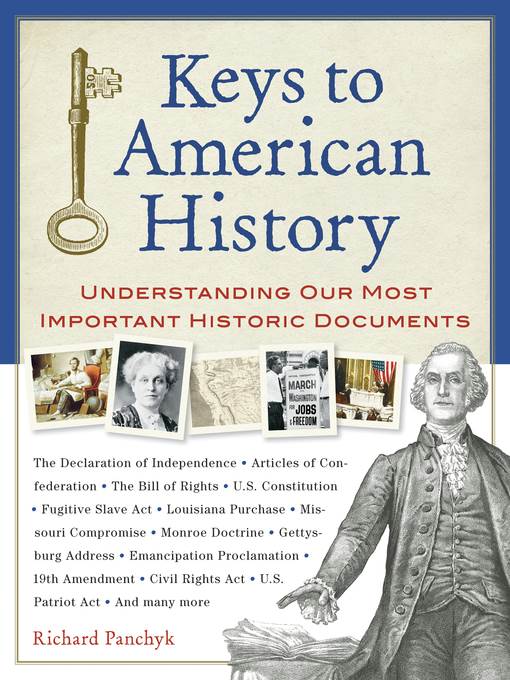
Keys to American History
Understanding Our Most Important Historic Documents
فرمت کتاب
ebook
تاریخ انتشار
2009
نویسنده
Richard Panchykناشر
Chicago Review Pressشابک
9781613742143
کتاب های مرتبط
- اطلاعات
- نقد و بررسی
- دیدگاه کاربران
نقد و بررسی

November 15, 2008
Since "many of the key moments in American history are associated with documents of some kind, " Panchyk pairs those moments to their relevant documents. From the 1606 Great Patent of James I to the 2002 Joint Resolution to Authorize the Use of United States Armed Forces in Iraq, each document is presented in context with a concise introductory comment, appearing both as facsimile reproduction and typescript, and followed by "What They Were Saying " (excerpts from primary sources that provide perspectives on those documents from major players and other contemporaries). Though readers may wonder if all inclusions are of equal importance —the Supreme Court case Bush v. Gore and the Emancipation Proclamation, for instance —the significance of each document is clearly delineated. Archival illustrations help the design keep the dense type from appearing too daunting for all but the most hardcore researchers. A one-of-a-kind, easy-to-use resource. (author 's note, questions to consider) (Nonfiction. 12 & up)
(COPYRIGHT (2008) KIRKUS REVIEWS/NIELSEN BUSINESS MEDIA, INC. ALL RIGHTS RESERVED.)

February 1, 2009
Gr 7 Up-This impressive collection is a valuable resource for gaining a greater appreciation for and understanding of our nation's dynamic history. The 72 entries range chronologically from the foundation of the American colonies with the Great Patent of James I in 1606 to the 2002 Joint Resolution to Authorize the Use of United States Armed Forces in Iraq. The volume documents such monumental episodes as the American Revolution, Civil War, Western Expansion, World War II, and the Civil Rights Movement. It contains all of the documents one would expect, such as the Constitution, Declaration of Independence, and Gettysburg Address as well as the lesser-known Antiquities Act of 1906, which protects historic national sites. Each document is prefaced with a brief introduction that gives students a reasonable degree of historical context. The author also includes a "What They Were Saying" segment that utilizes quotes of the day related to the documents. Each entry is accompanied by a variety of black-and-white portraits, maps, and facsimiles of the originals. While arguments will abound for the many documents left out, one cannot deny the seminal historical importance of those making the cut. Educators and AP students alike will find this volume valuable."Brian Odom, Pelham Public Library, AL"
Copyright 2009 School Library Journal, LLC Used with permission.

May 1, 2009
Grades 6-12 Panchyk compiled this chronologically arranged anthology so that students will have greater understanding of and insight into historical events by reading primary-source documents. Over 70 documents are arranged in eight categories: Foundations, including the Mayflower Compact and Thomas Paines Common Sense; Independence, including the Declaration of Independence and United States Constitution; Young Republic, including the 1793 Fugitive Slave Law and 1823 Monroe Doctrine; The Seeds of Trouble, including the 1832 Nullification Crisis and 1857 Dred Scott decision; Civil War, including the Confederate States of America Constitution and Lincolns Second Inaugural Address; Progress and Expansion, including the 1867 Reconstruction Act and 1906 Antiquities Act; America at War, including the 1917 Declaration of War and 1942 Japanese Relocation Order; and the Modern World, including the 1945 United Nations Charter and 2001 USA PATRIOT Act. Two curious omissions from this otherwise impressively thorough anthology are the 1830 Indian Removal Act and 1896 Plessy v. Ferguson decision.However, thisrich, diverse collection of primary-source documents offers excellent supplementary reading for anyone learning about U.S. history.(Reprinted with permission of Booklist, copyright 2009, American Library Association.)

























دیدگاه کاربران